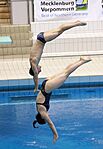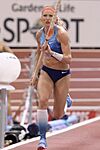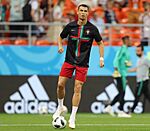Physical exercise facts for kids
Exercise means moving your body to stay strong and healthy. It helps you keep fit and feel good overall. People exercise for many reasons. Some want to lose weight or stay at a healthy weight. Others want to grow stronger, build muscles, or make their heart and lungs work better. Exercise also helps improve sports skills and just makes you feel happy! Many people like to exercise outside. They can meet friends, have fun, and boost their mood and mental health.
For good health, it's usually suggested to do about 2.5 hours of moderate exercise each week. But even a little bit of exercise is much better than none. Just 11 minutes of exercise every day can lower your risk of dying early. It also helps prevent heart disease, stroke, and cancer.
What Are the Main Types of Exercise?
Physical exercises are usually put into three main groups. These groups depend on how they affect your body:
- Aerobic exercise uses large muscle groups. It makes your body use more oxygen than when you are resting. The main goal of aerobic exercise is to make your heart and lungs stronger. Examples include running, cycling, swimming, fast walking, and dancing.
- Anaerobic exercise helps make your muscles firm and strong. It also builds muscle mass and makes your bones stronger. This type of exercise can improve your balance and coordination. Examples are push-ups, pull-ups, lunges, and squats. Weight training and sprinting are also anaerobic exercises. They help build short-term muscle strength.
- Flexibility exercises stretch and lengthen your muscles. Activities like stretching help your joints move better. They also keep your muscles bendy. The goal is to improve how much your joints can move. This can help you avoid injuries.
Exercise can also include training for accuracy, agility, power, and speed. Some exercises are called 'dynamic,' like steady running. They can lower your blood pressure while you exercise. Other exercises are 'static,' like weight training. They can cause your blood pressure to rise for a short time during the exercise.
How Exercise Helps Your Health
Physical exercise is super important for staying fit. It helps you keep a healthy weight and makes your digestion work well. It also builds strong bones and muscles. Exercise keeps your joints moving easily. It can make you feel good mentally and boost your immune system. Some studies even show that exercise might help you live longer and have a better quality of life.
People who exercise a lot tend to live longer than those who don't. Even moderate exercise can help prevent aging. This is because it reduces inflammation in the body. Doing about 3500 MET minutes of exercise per week gives you most of the health benefits. For example, climbing stairs for 10 minutes, vacuuming for 15 minutes, or running for 20 minutes daily can add up. Not being active causes many health problems. These include heart disease, type 2 diabetes, and some cancers.
Boosting Your Fitness
Most people can get fitter by moving their bodies more. When you do resistance training, your muscles can grow bigger. This depends a lot on what you eat and your body's natural hormones. Some people naturally get stronger faster than others. This is why elite athletes are so good. Exercising when you are middle-aged can help you stay physically able later in life.
Kids who learn motor skills early on are more likely to be active. This means they often do well in sports and are fitter. Good motor skills in childhood lead to more physical activity. But less developed motor skills can lead to a more inactive lifestyle.
The type and how hard you exercise can affect your fitness. There is some evidence that high-intensity interval training might improve your fitness slightly more than slower, longer workouts. However, some unproven fitness methods could lead to injuries.
A Stronger Heart and Lungs
Exercise is very good for your heart and blood vessels. Not being active is directly linked to heart disease. It is a major risk factor for heart problems. Low levels of exercise increase the risk of dying from heart disease.
Kids who exercise regularly lose more body fat. They also have stronger hearts and lungs. Studies show that stress from school can increase the risk of heart disease later in life. But regular exercise can greatly lower these risks.
Even a moderate amount of exercise, like burning 700-2000 calories a week, can lower the risk of death from all causes and heart disease. The biggest benefit is seen when inactive people start becoming moderately active. For women as they get older, regular exercise leads to a healthier heart. This is important because heart disease is a leading cause of death for women.
Moderate exercise is best for your heart. This means working out at 40-60% of your maximum effort. After a heart attack, people who start exercising regularly have a better chance of survival. People who are not active are most at risk for dying from heart and other diseases. The American Heart Association says exercise lowers the risk of heart attacks and strokes.
How Exercise Helps Your Immune System
Many studies have looked at exercise and the immune system. There is good evidence that moderate exercise helps your immune system. It can lower your chances of getting upper respiratory tract infections (like colds) by 29%. However, very long and intense exercise, like marathon running, might increase the risk of infections. Some studies show that athletes might be at higher risk for infections after very hard workouts. This is because intense stress can temporarily weaken the immune system.
Taking Vitamin C might help marathon runners get fewer colds. Exercise also helps reduce inflammation in the body. This is good because inflammation is linked to many long-term diseases.
Fighting Cancer with Exercise
Many studies show that being physically active is linked to lower death rates from all causes. It also lowers death rates from breast cancer and colon cancer. For people who have had cancer, exercise can improve their quality of life. It can help with anxiety, self-esteem, and feeling better emotionally. For people getting cancer treatment, exercise can help with tiredness and physical abilities. More intense exercise seems to have a bigger effect.
Exercise may help reduce tiredness in breast cancer survivors. Even though there is limited evidence, people with severe weight loss from cancer are encouraged to exercise. However, it can be hard for them to stick to an exercise plan.
For adults with blood cancers, aerobic exercise might slightly reduce depression and tiredness. But it may not make a big difference in how long they live or their physical abilities.
Exercise and Your Mood
Doing continuous aerobic exercise can make you feel really happy. This is sometimes called a "runner's high" or "rower's high." It happens because your body makes more feel-good chemicals like anandamide and endorphins.
Better Sleep with Exercise
Early studies suggest that exercising for up to four months can improve sleep quality for adults over 40. A 2010 review found that exercise generally helps most people sleep better. It might even help with insomnia. A 2018 study also showed that exercise can improve sleep quality for people with insomnia.
Breathing Easier
People who exercise regularly have stronger hearts and lungs. There is some concern about breathing in more air pollution when exercising outdoors, especially near busy roads.
How Exercise Works in Your Body
Your Muscles and Exercise
When you do resistance training and eat enough protein, your muscles grow bigger and stronger. This happens because your body builds more muscle protein. Eating protein also helps stop muscle breakdown.
Aerobic exercise helps your muscles make more mitochondria. These are like tiny power plants in your cells. More mitochondria mean your muscles can use oxygen better. This helps you do endurance activities for longer.
Other Body Parts and Exercise
New research shows that muscles act like endocrine organs. This means they release substances called myokines when you exercise. These myokines help new tissue grow and repair damaged tissue. They also have anti-inflammatory effects, which can reduce the risk of many diseases. Exercise also lowers levels of cortisol, a stress hormone that can cause health problems. Exercising before meals can lower your blood sugar more than exercising after meals.
Very intense exercise might make your heart muscle thicker. This thickening of the heart walls is usually healthy when it happens because of exercise. Both aerobic and anaerobic exercise make your heart work more efficiently.
Exercise and Your Brain
Exercise helps your brain in many ways. This might be partly because muscles release special hormones into your blood. These include BDNF, IGF-1, and VEGF. These hormones help your brain grow and stay healthy.
Exercise in Communities and Schools
Many communities and schools try to get people to be more active. They use campaigns and programs. There is some evidence that certain exercise programs for older adults can improve their balance. After doing strength training, older adults also move better.
Simple things can help, like signs that encourage using stairs. Cities like Bogotá, Colombia, even close off roads on Sundays. This makes it easier for people to walk, bike, and exercise. These special zones help fight diseases and keep people at a healthy weight.
Parents can encourage physical activity by being active themselves. They can also help their kids find ways to exercise. In the United States, children and teens should get 60 minutes or more of physical activity every day. Schools should also help kids be active and remove things that stop them from living a healthy life.
The European Commission has programs and money for projects that promote healthy physical activity. This is because many Europeans are not active enough. They want to help people work together and promote exercise across Europe.
Exercise Trends Today
Around the world, jobs have become less physically demanding. People use more cars and have more labor-saving devices at home. They also do fewer active hobbies. But changing your personal lifestyle can fix this lack of exercise.
Research from 2015 suggests that adding mindfulness to exercise helps people stick with it. It also makes them feel better mentally and physically.
- Sports activities for exercising
-
Running helps in achieving physical fitness.
-
Skateboarding is good for cardiovascular health.
-
Athletics (ex. pole vault) as a form of exercise
-
Football as an exercise
How Exercise Differs Around the World
Exercise looks different in every country. The reasons people exercise also change. In some places, people exercise mostly indoors, like at home or gyms. In others, they prefer to exercise outside. People might exercise for fun, health, to meet friends, or for sports training. These differences can be due to where people live and their social customs.
For example, in Colombia, people love their outdoor spaces. They often use outdoor activities to socialize and enjoy nature. In Bogotá, a 70-mile road called the Ciclovía is closed every Sunday. This lets people bike, run, skate, and exercise while enjoying their surroundings.
In Cambodia, people also tend to exercise socially outdoors. Public gyms have become very popular there. People gather at these outdoor gyms not just to use the equipment. They also organize aerobics and dance sessions that anyone can join.
Sweden has also built outdoor gyms called utegym. These gyms are free and often in beautiful natural places. People swim in rivers, use boats, and run through forests to stay healthy. This works well in Sweden because of its many natural areas.
In some parts of China, especially for retired people, exercise is very social. In the mornings, square dances are held in public parks. These can include Latin dancing, ballroom dancing, or even the jitterbug. Dancing in public helps people meet others and offers both health and social benefits.
These examples show how people in different places exercise in different ways. They also show how exercise can improve health and well-being. It can also strengthen community ties and help people enjoy nature.
Eating Right and Recovering After Exercise
Eating well is just as important as exercise for your health. When you exercise, it's even more important to eat a good diet. This makes sure your body gets the right balance of macronutrients (like protein and carbs). It also provides enough micronutrients (vitamins and minerals). This helps your body recover after hard exercise.
After exercising, it's good to do "active recovery." This means doing light activity, like a slow walk. It helps remove lactic acid from your blood faster than just resting. Removing lactic acid helps your body temperature cool down slowly. This can also help your immune system.
Experts suggest a "4-Rs framework" for recovery:
- Rehydration
- Drink fluids and electrolytes to replace what you lost.
- Refuel
- Eat carbohydrates to refill your muscle and liver energy stores.
- Repair
- Eat good quality protein. You can also add creatine monohydrate.
- Rest
- Get plenty of good sleep after exercise. Eating casein proteins, antioxidant-rich fruits, and high-carb meals can help with this.
Exercise can affect your appetite. Whether it makes you more or less hungry depends on the person and how hard or long you exercise.
A Brief History of Exercise
People have known about the benefits of exercise for a very long time. Back in 65 BCE, a Roman politician named Cicero said, "It is exercise alone that supports the spirits, and keeps the mind in vigor." In the Middle Ages, exercise was also important for survival.
More recently, exercise became very valued in the 1800s. In 1858, Archibald MacLaren opened a gym at the University of Oxford. He created a training plan that was later used by the British Army. This made sports an important part of military life. In the early 1900s, many group exercise movements started. A big one in the UK was the Women's League of Health and Beauty, started in 1930. It had 166,000 members by 1937.
The strong link between physical health and exercise was shown in 1949 by a team led by Jerry Morris. He noticed that bus conductors, who moved around a lot, had fewer heart attacks than bus drivers, who sat all day. This showed how important exercise was for heart health.
Types of Physical Exercises
Images for kids
-
Running in water (aquarunning)
See also
 In Spanish: Ejercicio físico para niños
In Spanish: Ejercicio físico para niños



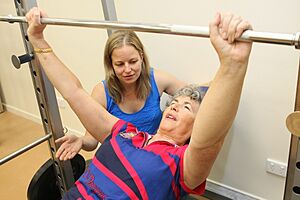
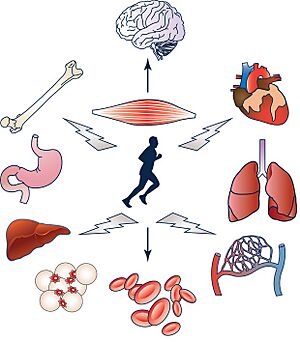
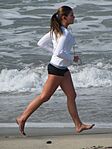
![Skateboarding is good for cardiovascular health[better source needed]](/images/thumb/2/22/Cruising_on_a_Board.jpg/150px-Cruising_on_a_Board.jpg)
